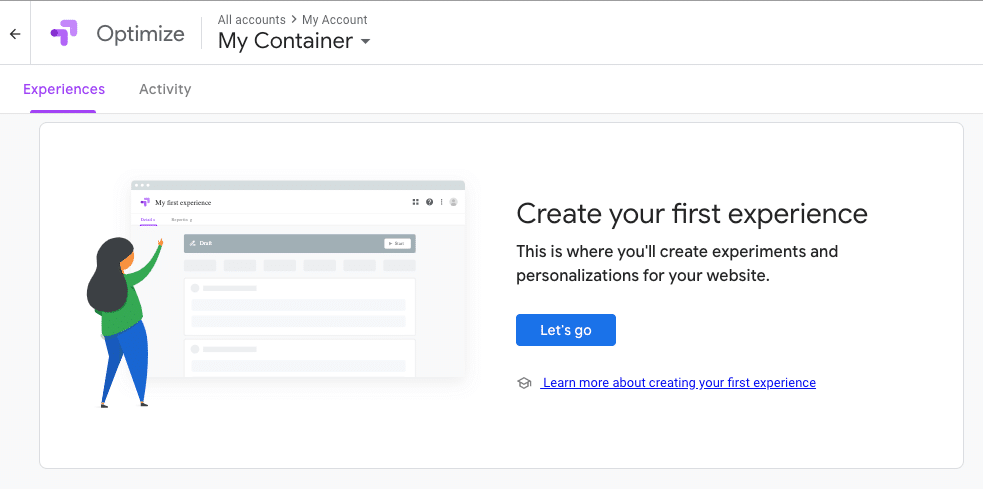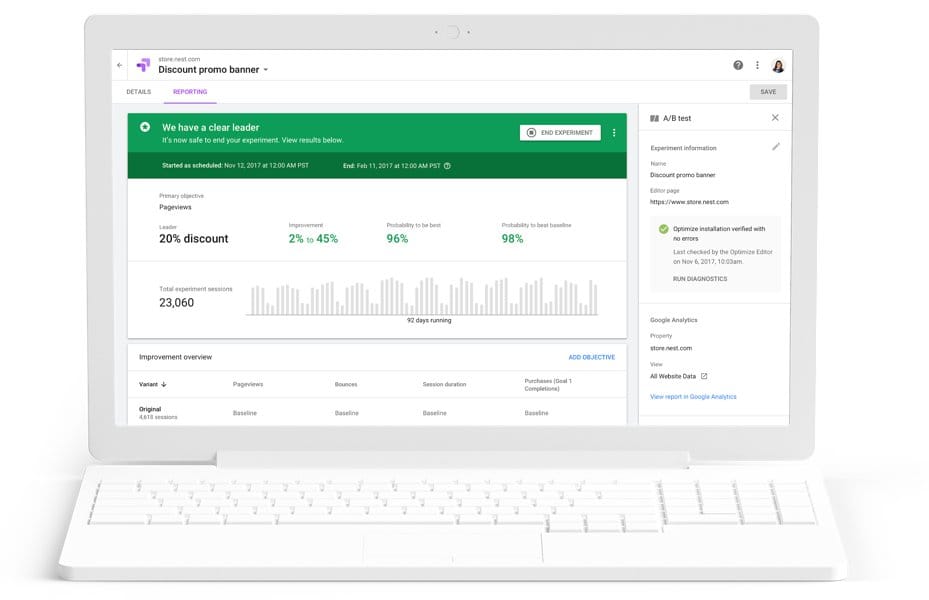As marketers, we all want a better understanding of what gets visitors to convert and what might be falling flat. But it’s all but impossible to gain this understanding without data, research and testing. Even after you do your research and develop a kick-ass content strategy, it’s hard to know exactly how specific things will perform.
That’s why many marketers embrace A/B and multivariate testing with open arms. Are you regularly testing your various marketing tactics? If so, you’ve probably already heard of or even regularly use Google Optimize. If you’re new to the content experiments world, Google Optimize allows you to easily initiate continuous testing to determine the best content for your audience.
For those in the latter category, let’s dig in deeper.
What Is Google Optimize?

Google Optimize is a killer Google product that allows you to test different variants of web pages and track how they perform. The application monitors the results of your experiment and informs you of which version is getting the best results.
For example, you may want to test different aspects of a landing page geared toward getting customers to sign up for a demo. Within this page, you can test a variety of different elements from button colors to call-to-action text to images.
Why Run Tests?
Unless your content converts 100 percent of the time, there is always room for improvement. You can dig deep into your content analytics to learn a lot about how your audience relates to it, but it wouldn’t deliver insights like testing does.
Google Optimize allows you to split incoming traffic to a specific page into page variations. This process sounds a lot like traditional A/B testing, but it expands on the idea significantly.
A/B Testing vs. Multivariate Testing
In standard A/B testing, there is only one variant. You choose one specific element that’s different, such as different subject lines for an email. The results you receive on this type of experiment tell you only about that one variable (which subject line performed better). If you don’t have a clear winner between the two versions, it’s hard to know if that variant mattered at all. Further, without a high volume of test subjects, the results may have little to no impact on future variations.
Multivariate testing allows you to have multiple variables. It’s an extension of standard A/B testing but offers you the opportunity to test various hypotheses.
Multivariate testing has many advantages over A/B testing. You can use two very different versions of a page, enabling you to determine what resonates with buyers and what doesn’t. Not only can you learn from the page that performs the best, but you can also learn from the one that had the poor performance so you can figure out why it wasn’t meaningful. You can use that to inform your next iteration.
Why Use Google Optimize to Test Content
There are lots of tools available that allow you to do A/B testing. So, why is Google Optimize a good choice? Google Optimize syncs with your Google Analytics data so you can judge results and test more options with Optimize dimensions in Google Analytics. It also ties in with Google Ads, so you can actually target specific users that come from specific campaigns, ad groups, or keywords.
Finally, the standard version is free. There is a paid version called Optimize 360, which is best for enterprise and high-volume testing. Most companies will do fine with the free version.
How to Run Tests in Google Optimize

The process of setting up a test in Google Optimize is straightforward. Anyone already familiar with Google applications will find it easy.
First, you choose the type of test you want to run—A/B or multivariate. Then, you’ll need to add a snippet of code to the page you are testing. When you create an experience, you’ll name it. On the test page, you’ll find a guide that takes you through each step, explaining each one.
Next, you’ll start the Optimize Editor to determine the variants for your second version. Prior to this step, you should have already mapped out possible variants, which could include things like:
- Static images vs. video
- UX variables like button styles or navigation
- Content variations, specifically headlines, primary messaging and calls to action
The Optimize Editor is very intuitive, as long as you have the code snippet installed correctly. You then have the option to make changes to the page. You can edit text and HTML, as well as insert new HTML. The best part is that you do not have to be a developer or website designer to use this tool.
Next, you’ll preview your changes to make sure everything looks as it should and do a quick QA review. Then, you’ll hit save and move to the next step, which requires setting up an objective in Google Analytics. This is a crucial step because it’s what will decide the winner of the experiment.
There are multiple pre-set Google Analytics goals such as lead submission form, or revenue if you’re testing an eCommerce page. You also have the option of creating a custom option based on an event.
Then it’s time to launch your test, which you can either do automatically or by scheduling. Once it’s launched, you’ll need to verify that data is streaming into the platform. You can do this with the Optimize reporting tab or via the Google Analytics view you created. Most marketers prefer to see the Google Analytics view because it’s easier to understand and the Optimize report has a time delay.
When Should You End the Test?
If Optimize found a clear winner over a period of time (at least three weeks), it’s time to analyze. However, this doesn’t always happen. When Optimize finds a winner, they define it as a “probability to beat baseline,” which means that the winning variant has a percentage probability of outperforming the other version.
When you do end the test, you can document the test and its results in a summary that you can then carefully analyze with stakeholders to inform what permanent changes you should make to that page. Remember, if you’ve chosen multiple variations, you’ll need to consider the weight of each of these in performance.
Ready to get testing! Try out Google Optimize today and discover what content your target buyers love.